|
Celebrating Orthodox Christmas
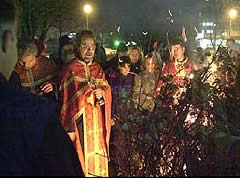  Orthodox Christmas celebrations begin on the evening of 5 January, known as kolede. Children go from door to door singing Christmas carols and receiving fruits, nuts, and sweets from the people. Later in the evening, the elderly gather around a fire outside and engage in a conversation about the past year and about the year to come. Orthodox Christmas celebrations begin on the evening of 5 January, known as kolede. Children go from door to door singing Christmas carols and receiving fruits, nuts, and sweets from the people. Later in the evening, the elderly gather around a fire outside and engage in a conversation about the past year and about the year to come.
The following evening is Christmas Eve, when traditional oak log (badnik) is brought to the family hearth. This log is cut by the male head of the household and the older son, while the table is being set for the Christmas Eve Fast supper (posna vecera). The log is cut into three pieces, representing the Holy Trinity, and each piece is brought into the house by the father. A son or some other member of the family receives each piece and places it on the fire. As this is done, the son and the father exchange a greeting: "Good evening and happy Christmas Eve" (dobra vecer i vesel Badnik).
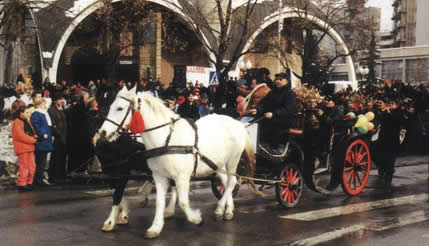  While the log is being placed on the fire, the mother and the grandmother gather the children together and, from the outside, enter into the room where the supper is to be served. Each person carries a bundle of straw and the mother leads the children in spreading around the room the straw on the floor. The house is decorated with oak branches with their leaves on, representing the wish of the family for long and healthy life, "with health strong as oak and with a life log as that of the oak." Then the fasting supper is served on the same table that the Christmas candle is burning. While the log is being placed on the fire, the mother and the grandmother gather the children together and, from the outside, enter into the room where the supper is to be served. Each person carries a bundle of straw and the mother leads the children in spreading around the room the straw on the floor. The house is decorated with oak branches with their leaves on, representing the wish of the family for long and healthy life, "with health strong as oak and with a life log as that of the oak." Then the fasting supper is served on the same table that the Christmas candle is burning.
The fasting supper is composed of strict vegetarian recipes, such as cooked vegetables, nuts, bread (pogaca), and dried fruits. In the bread, a coin is being put before it is baked. The traditional belief is that whoever gets the coin will have a particularly successful year to look forward to. The Christmas candle is then lit and everyone sings a Christmas hymn.
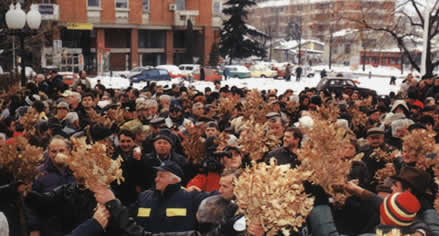  Very early on Christmas Day, people attend the first morning church service. After the family returns from church, the first guest arrives. This is usually a man who is a dear friend of the family and he is especially honoured during the celebration. When he first arrives he goes to see the yule log fire. He is then met by the host, who kisses him and gives him this special greeting: "CHRIST IS BORN" (Hristos se rodi). The guest replies: "INDEED, HE IS BORN" (Voistinu se Rodi). These greetings are exchanged throughout the three days of Christmas. After the greeting exchange, the guest shakes the burning oak log and when the sparks fly up, he recites his best wishes for the family. He usually does this in rhyme, mentioning the special desires of the family. Christmas dinner usually consists of roast suckling pig and other festive dishes; the very festive meal begins and the celebration continues for three days. The festive meal has to be rich and should include meat, as it is meant to celebrate the birth of Jesus after the strict Orthodox Lent. Very early on Christmas Day, people attend the first morning church service. After the family returns from church, the first guest arrives. This is usually a man who is a dear friend of the family and he is especially honoured during the celebration. When he first arrives he goes to see the yule log fire. He is then met by the host, who kisses him and gives him this special greeting: "CHRIST IS BORN" (Hristos se rodi). The guest replies: "INDEED, HE IS BORN" (Voistinu se Rodi). These greetings are exchanged throughout the three days of Christmas. After the greeting exchange, the guest shakes the burning oak log and when the sparks fly up, he recites his best wishes for the family. He usually does this in rhyme, mentioning the special desires of the family. Christmas dinner usually consists of roast suckling pig and other festive dishes; the very festive meal begins and the celebration continues for three days. The festive meal has to be rich and should include meat, as it is meant to celebrate the birth of Jesus after the strict Orthodox Lent.
Source: faq.macedonia.org
Vevcani Carnival - Struga
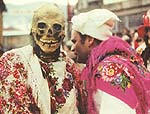  The village of Vevcani is situated on the west side of the Debar-Struga highway, just 15km away from Struga and Lake Ohrid. On the night between 13-14 January every year the carnival of Vasilica (Macedonian Orthodox New Year) takes place in this village. This carnival is one of the most attractive events in Macedonia. The participants, with a realistic sense of humour, satire, and sarcasm, mark the events of everyday life and mainly mock the authorities and the power they represent. The carnival in this small village is 14 centuries old and is included in the world carnival list. The village of Vevcani is situated on the west side of the Debar-Struga highway, just 15km away from Struga and Lake Ohrid. On the night between 13-14 January every year the carnival of Vasilica (Macedonian Orthodox New Year) takes place in this village. This carnival is one of the most attractive events in Macedonia. The participants, with a realistic sense of humour, satire, and sarcasm, mark the events of everyday life and mainly mock the authorities and the power they represent. The carnival in this small village is 14 centuries old and is included in the world carnival list.
Read more
Epiphany Festivities in Macedonia
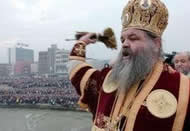  This is in memory of the day Jesus was baptized. In some places, there is a procession from the church to the nearest body of water, such as a river or a lake. The water is blessed by the priest and a cross is thrown into the water. People then rush into the water to catch the cross. Whoever gets the cross is believed to have a very exciting year coming up. This is in memory of the day Jesus was baptized. In some places, there is a procession from the church to the nearest body of water, such as a river or a lake. The water is blessed by the priest and a cross is thrown into the water. People then rush into the water to catch the cross. Whoever gets the cross is believed to have a very exciting year coming up.
Since Epiphany always takes place in winter, catching the cross in the water is usually done by young people. Interestingly enough, as cold as it may be outside, there has not been a case of a person that got into the blessed water of getting ill. Some of the blessed water is taken home in small containers as a symbol of purity and protection from illness, and is kept near the family icon.
The most interesting Epiphany festivities in Macedonia are on the Stone Bridge over the river Vardar in Skopje and on Lake Ohrid.
Source: faq.macedonia.org
St. Athanasius (Tanasovden)
Among the numerous Christian holidays observed by the Gypsies of Macedonia (Mitrovden, St. George, St. Nicholas, etc.), Tanasovden is celebrated by almost every family. Relatives, friends, and neighbours are invited and visited.
The day always falls on 31 January. On 29 January, a rooster is bought and it stays the night in the house and sings during the day. It is slaughtered on 30 January and is served along with beans with spare ribs, cabbage rolls, and sweets.
The first thing laid on the table is a pie called pogaca. Three candles are stuck in it and lit. A bowl of boiled wheat is placed next to the pogaca. The eldest member of the family and then everyone else help themselves to the wheat, with which they go round the pogaca in circles, after which dinner is served.
Among other foods, fish is normally served for lunch on the following day, the Day of St. Athanasius. |